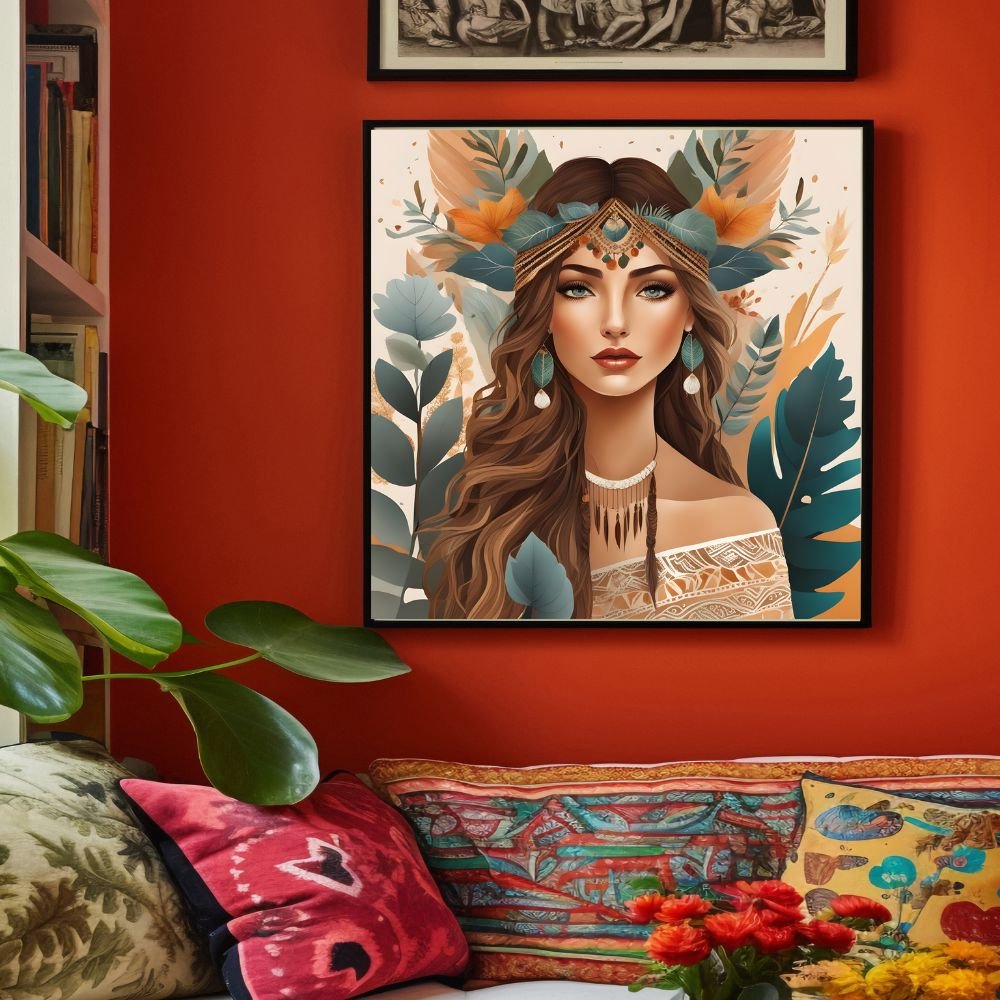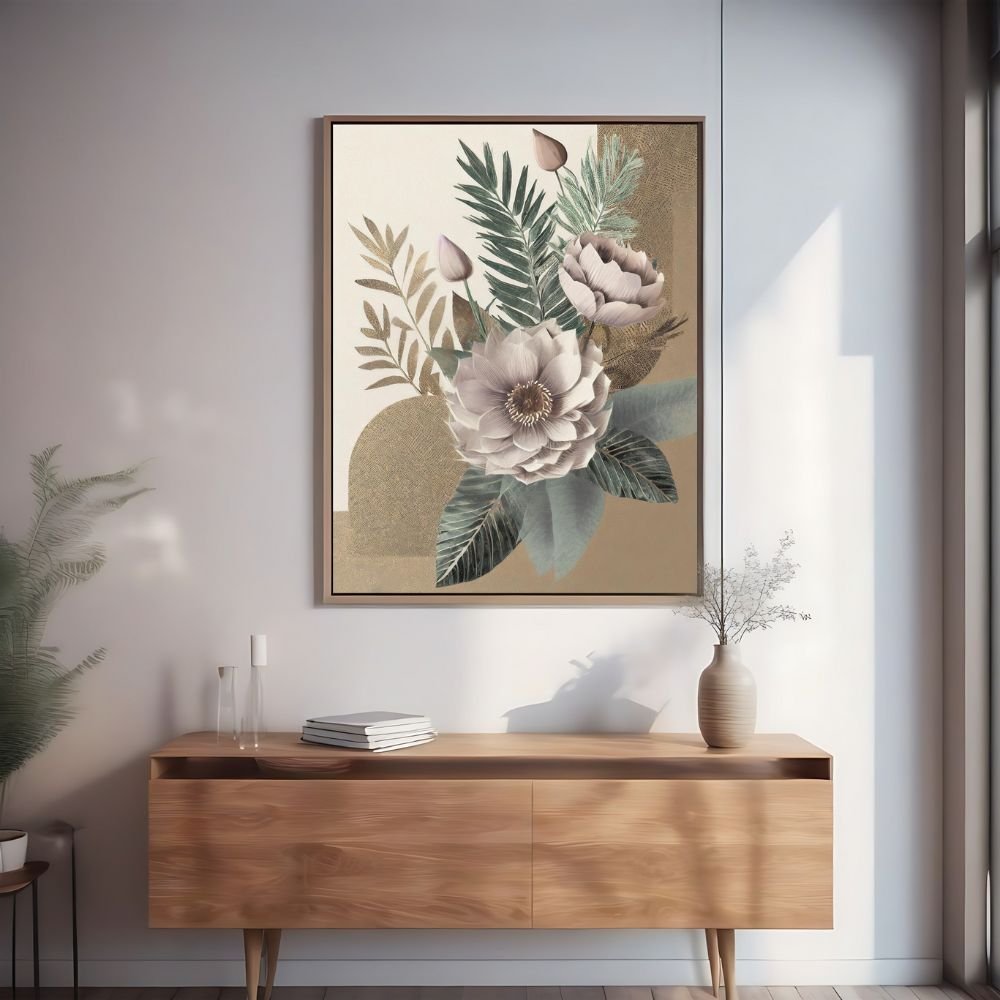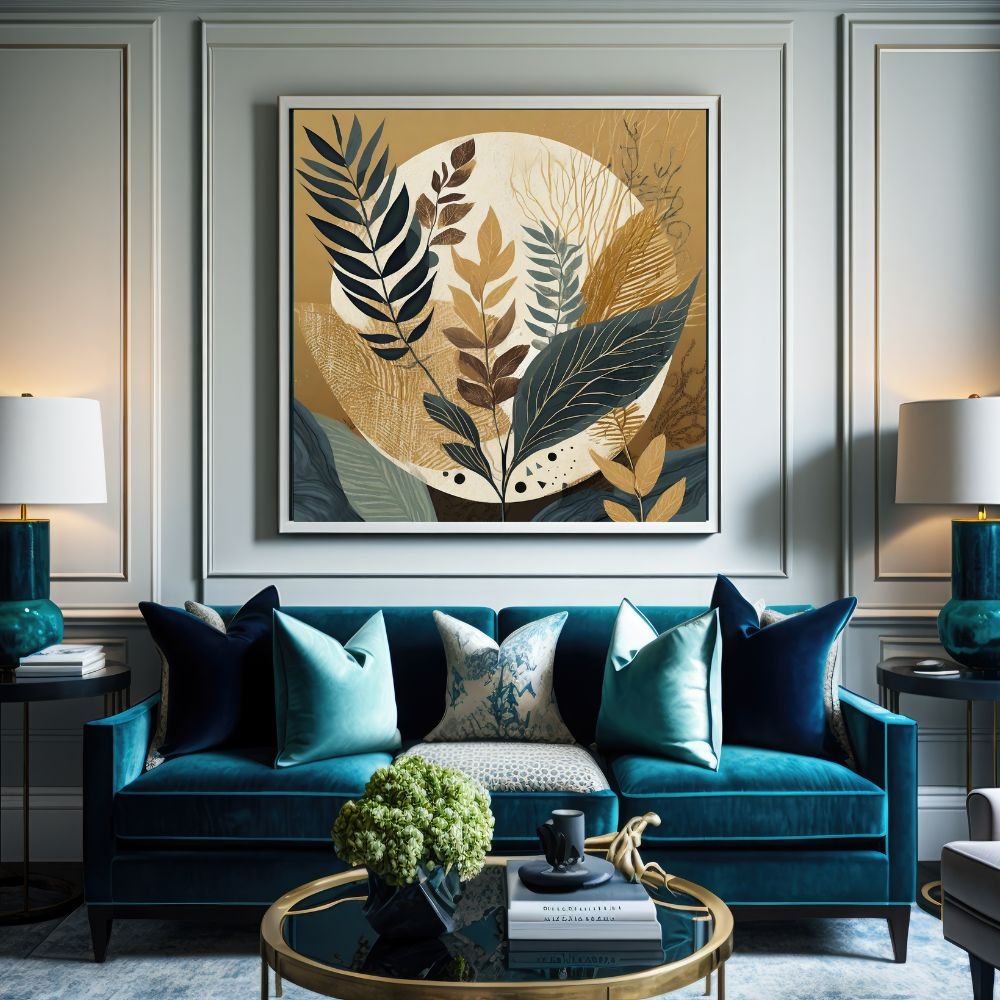Boho style, a term that captures the essence of being free-spirited. Creative, weaves a rich tapestry of color, pattern, and vibrancy into any space. Celebrating individuality and a laid-back, eclectic design philosophy. Bohemian, or “boho,” design draws inspiration from the artistry who prize the textures, patterns, colors, and motifs of nature. They advocate for a “more is more” approach.
This allows for a personal, maximalist or minimalist interpretation. The key to boho style lies in mixing, matching, layering, and exploring, transforming spaces into comfortable and meaningful areas. That reflect one’s personal journey and encounters with diverse cultures and artistic expressions. And Unlocking the Mystique of Boho Art, A Deep Dive into Bohemian Design Style.
This approach to interior decorating fully embraces playful colors, textures, and patterns. Characterized by its thoughtful maximalism that carefully curates and layers multicultural artwork, textiles, and decorative objects. To tell a story that is as unique and creative as its creator.
Boasting a free-spirited aesthetic that marries different cultures and artistic expressions. Boho interior design stands out for its emphasis on organic elements and nature, encouraging the mixing of patterns, materials, and trinkets from travels to craft spaces that are not only visually captivating but also deeply personal.

The Historical Roots of Boho Art
Definition and Origins
Bohemianism, originally a French term, evolved to describe the unconventional lifestyles of marginalized artists in 19th-century Paris. These individuals, often impoverished, rebelled against societal norms to pursue artistic freedom.
Influencing what would later be known as Boho chic .The term ‘Bohemian’ was derived from the French ‘Bohémien,’ used for the Romani people. Who believed to have originated from Bohemia, a misconception that added to the style’s mystique.
Influence of the Romani Culture
The Romani people, with their nomadic lifestyle and vibrant cultural expressions, profoundly impacted the aesthetic that characterizes Bohemian style today. This influence is evident in the free-spirited and eclectic fashion choices that define Boho chic. Reflecting a blend of various cultural elements . The term ‘Bohemian’ itself became synonymous with a lifestyle unconstrained by mainstream societal standards, celebrating creativity and diversity .
19th Century Bohemianism
In the 19th century, Bohemianism was romanticized through literature and music. Capturing the hearts of those yearning for a life outside conventional boundaries. Iconic works like Henri Murger’s Scènes de la vie de bohème glorified this lifestyle.
This was promoting a narrative of artistic and personal freedom that resonated with many. This era also saw the rise of Bohemian enclaves in major cities. Where artists and intellectuals gathered to live and create freely, often in stark contrast to the prevailing societal norms .
Boho Art in Fashion and Interior Design
Key Characteristics of Boho Style
Boho style, characterized by its eclectic and unconventional approach, integrates various elements from different cultures and historical periods. This style is marked by vibrant colors, intricate patterns, and a mix of textures, creating a visually rich and layered aesthetic. I
It often includes handmade items and natural materials, emphasizing individuality and artistic expression. The use of earthy tones alongside bright, bold colors allows for a dynamic . And inviting atmosphere, while accessories like beads, fringes, and tassels add a distinctive bohemian flair.
Boho Fashion Through the Ages
The evolution of boho fashion is deeply intertwined with cultural shifts and artistic movements. Originating in the late 18th century, boho style was initially adopted by artists and intellectuals in Paris.
They expressed their creativity through their attire during a time of economic hardship. By the mid-19th century, this style had become synonymous with a free-spirited lifestyle, opposing mainstream fashion and societal norms.
The 1960s and 70s saw a significant revival as the hippie movement embraced boho fashion. Celebrating freedom and resistance to materialism through vibrant fabrics and relaxed silhouettes. Today, boho fashion continues to influence modern wardrobes, incorporating contemporary elements while retaining its unique and relaxed ethos .
Boho Interior Design Principles
Bohemian interior design is a reflection of the philosophy behind boho fashion—freedom, eclecticism. And a connection with artistic and cultural elements. This design style is characterized by a lack of strict rules. Allowing for a personalized space that incorporates an array of colors, patterns, and textures.
Key elements include layering of textiles like rugs and throws, use of vintage and handmade furniture. And an abundance of greenery to bring life and vibrancy to living spaces.
Lighting is kept soft and ambient to complement the rich colors and textures, creating a warm and inviting environment . Boho interiors are not only about aesthetics but also about creating a space that feels lived-in, comfortable, and reflective of one’s personal journey and artistic inclinations .
Influential Figures and Moments in Boho Art
Icons of the Bohemian Style
The Boho art movement, initially sparked in the early 1960s in New York. Which saw significant contributions from artists like Jean-Michel Basquiat and Keith Haring. Who brought fresh perspectives and vibrancy to the scene. This period also marked the emergence of influential figures.
Such as Trenton Doyle Hancock. Whose work incorporated African American cultural themes into colorful and geometric images, earning him a Guggenheim Fellowship in 2013 . The term “boho” itself was coined by Françoise Gilot in 1964. Capturing the essence of bohemian chic that opposed luxurious styles, favoring simplicity and authenticity .

Historical Events Impacting Boho Art
Key historical moments have significantly shaped the evolution of Boho art. For instance, the 1964 exhibition at the Pierre Matisse Gallery in New York. Introduced Parisian bohemian style to a broader audience. Marking a pivotal moment in the establishment of Bohemian chic.
This event coincided with a broader acceptance and integration of bohemian aesthetics into mainstream culture. Further popularized by icons like Jane Morris and Effie Gray in the 19th century. Who challenged conventional fashion with their unrestricted, flowing dresses.
The liberation of Paris in 1944 also highlighted the bohemian spirit. With women donning colorful peasant skirts and flowers in their hair, a stark contrast to the grimness of war. These moments not only influenced fashion but also echoed a deeper cultural and artistic acceptance of the boho philosophy.
Boho Art Today: Adapting to Modern Tastes
Contemporary Boho Fashion Trends
The fashion landscape has witnessed a significant transformation with the resurgence of boho chic. Characterized by a blend of colorful, folk-inspired elements and modern simplicity.
This trend, which has stormed both the ramps and high streets, emphasizes slimmer silhouettes. Also well-coordinated prints, paired with contemporary accessories . The modern boho aesthetic has moved away from excessive frills towards more travel-friendly and accessible designs.
Focusing on comfort over adornment . Notable fashion icons like Jennifer Lopez have demonstrated this refined approach. Where the emphasis is on structured, balanced outfits with a touch of moderation, showcasing standout boho elements without overwhelming the senses .
Modern Interpretations in Interior Design
In interior design, the Modern Bohemian style marries sleek, modern lines with the eclectic, textured elements typical of bohemian decor. This style is characterized by a base palette of neutral, understated materials such as light-hued wood and chic grey accents, overlaid with textured materials like sisal and jute.
The challenge lies in balancing these contrasting styles to create a harmonious environment that reflects both modern chic and bohemian vibrancy . The color palette employs a mix of natural colors like brown and taupe, accented with bolder shades to enhance the visual impact and maintain the bohemian spirit.
Furniture selection plays a crucial role, with major pieces like sofas and dining tables featuring modern designs, while accent pieces like coffee tables and chairs bring in the bohemian flair . This approach allows for a dynamic yet cohesive space that embodies the essence of Modern Bohemian design.

How to Incorporate Boho Art into Your Lifestyle
Boho art, with its eclectic and vibrant appeal, can be seamlessly integrated into your lifestyle through fashion and home decor. This style, characterized by a free-spirited and natural aesthetic. This offers a unique opportunity to express individuality in both personal attire and living spaces .
Fashion Tips and Tricks
- Embrace Individual Expression: Start by mixing and matching different patterns, textures, and colors to create outfits that reflect your unique style. Boho fashion is all about personal expression, so don’t shy away from combining various elements to see what works for you .
- Incorporate Key Pieces: Include items like denim shorts, kimono tops, or batwing tops, which are staples in boho fashion. These pieces provide a relaxed, yet stylish base that you can build upon with accessories .
- Accessorize Wisely: Boho style places a significant emphasis on accessories. Layer multiple chains, add vibrant scarves, or choose hats that complement your outfit to enhance the boho feel. Remember, accessories like jewelry and bags can make or break your boho look .
- Choose Natural Fabrics: When selecting clothing, opt for natural fabrics like suede, crochet, and lace. These materials are not only eco-friendly but also add an authentic touch to your boho style .
DIY Boho Home Decor Ideas
- Macrame and Woven Baskets: DIY projects like creating macrame wall hangings or woven baskets can add a bohemian flair to any room. These handcrafted items bring warmth and texture to your space, making it more inviting .
- Custom Vases and Mirrors: Transform simple items into boho decor pieces. For instance, take a plain glass vase or jar and use materials like raffia or wooden skewers to create a unique boho-style vase or a decorative mirror .
- Use Natural Elements: Incorporate elements such as plants, wooden accents, and natural textiles to turn your home into a boho oasis. These components not only beautify the space but also promote a relaxing and earthy environment .
- Personalized Art Pieces: Utilize everyday items to craft personalized decor. For example, paint a thrifted frame with a monstera leaf design or use crisp proof paper to make a custom palm leaf decoration .
By integrating these fashion tips and DIY home decor ideas into your daily life, you can fully embrace the boho art style, making it a part of your identity and living environment.

The Future of Boho Art: Trends to Watch
Innovations in Boho Design
The bohemian style continues to evolve, embracing new materials and techniques while maintaining its core principles of eclecticism and personal expression. Innovations in Boho design are increasingly influenced by sustainable practices, with a growing emphasis on using eco-friendly materials such as bamboo, rattan, and recycled fabrics.
This shift not only reflects a broader trend towards environmental consciousness but also enhances the intrinsic connection between Boho decor and nature. Additionally, the integration of global artisan crafts into mainstream decor highlights a trend towards cultural appreciation and support for local economies, making each piece a testament to both beauty and ethical consumption .
Boho Art in the Digital Age
The digital realm has significantly transformed Boho art, introducing new platforms and technologies that redefine how art is created and experienced. Digital art platforms like Arts Fiesta have revolutionized the Indian art scene by enabling artists to explore digital brushstrokes and immersive experiences, which challenge traditional art forms.
The adoption of virtual and augmented reality technologies allows artists to create engaging, three-dimensional art installations that offer viewers a new level of interaction and immersion, blending the physical with the digital .
Furthermore, the rise of NFTs has introduced a novel method of owning and trading digital art, providing artists with unprecedented opportunities to monetize their work while expanding their audience beyond traditional galleries . This fusion of technology and art not only broadens the scope of Boho aesthetics but also invites a dialogue on the future of artistic expression in an increasingly digital world .
Conclusion
Throughout this exploration of Boho art, we’ve journeyed from its historical roots in 19th-century Parisian culture to its modern incarnations in fashion and home decor.
We’ve seen how Boho style celebrates personal expression, creativity, and a harmonious blend of various cultural influences, demonstrating a unique fusion of the old and the new. This journey highlighted the style’s evolution, adapting to contemporary tastes while staying true to its core ethos of freedom, eclecticism, and a deep connection with nature and artistic expression.
As we look ahead, the future of Boho art appears vibrant and promising, enriched by advances in digital technology and a growing focus on sustainability. These developments promise to expand the possibilities of Boho expression and accessibility, further blurring the lines between traditional and modern, and between the physical and digital realms. By embracing these trends, individuals have the opportunity to redefine their personal and living spaces, making Boho art a continually evolving testament to individuality and cultural fusion.
FAQs
1. How do boho and bohemian design styles differ? Boho, or urban boho, incorporates the fundamental elements of traditional bohemian design like rattan, macramé, and ethnic patterns found on pillows and rugs. However, it distinguishes itself by integrating modern and unexpected features, enhancing the classic bohemian aesthetic with a contemporary twist.
2. What are the essentials for achieving a bohemian or boho style? To create a bohemian or boho look, mix various patterns, textures, and colors. Accessories play a vital role in this eclectic and free-spirited style. Incorporating unique and handmade items such as hand-woven tapestries, brightly patterned rugs, and colorful throw pillows can significantly elevate the bohemian vibe in any space.
3. Can you explain the concept of bohemian design? Bohemian design, often referred to as Boho, is deeply rooted in natural elements both literally and visually. Justina Blakeney, a designer and creator of Jungalow, emphasizes the importance of plants in boho decor, as they bring life, air, and energy into the setting. This style is characterized by a combination of vibrant colors and geometric patterns, aiming for a maximalist rather than minimalist aesthetic.
4. What defines the bohemian style? Bohemian style, also known as boho style, is considered an ‘FOREGIN’ trend extensively adopted not only in fashion but also in interior design and literature. It’s recognized for its eclectic and unconventional vibe, which has been embraced by various artists, including poets who often reference bohemian concepts in their works




Pingback: What Is Boho Art Painting? a Fusion of Creativity and Nature - ByRetreat
Pingback: Boho Landscape Coloring Pages for Adults - 101 Creative Coloring Pages
Pingback: Retro Revival
Pingback: Bohemian Bedroom Decor with a Modern Twist